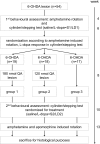L-dopa response pattern in a rat model of mild striatonigral degeneration
- PMID: 31181111
- PMCID: PMC6557500
- DOI: 10.1371/journal.pone.0218130
L-dopa response pattern in a rat model of mild striatonigral degeneration
Abstract
Background: Unresponsiveness to dopaminergic therapies is a key feature in the diagnosis of multiple system atrophy (MSA) and a major unmet need in the treatment of MSA patients caused by combined striatonigral degeneration (SND). Transgenic, alpha-synuclein animal models do not recapitulate this lack of levodopa responsiveness. In order to preclinically study interventions including striatal cell grafts, models that feature SND are required. Most of the previous studies focused on extensive nigral and striatal lesions corresponding to advanced MSA-P/SND. The aim of the current study was to replicate mild stage MSA-P/SND with L-dopa failure.
Methods and results: Two different striatal quinolinic acid (QA) lesions following a striatal 6-OHDA lesion replicating mild and severe MSA-P/SND, respectively, were investigated and compared to 6-OHDA lesioned animals. After the initial 6-OHDA lesion there was a significant improvement of motor performance after dopaminergic stimulation in the cylinder and stepping test (p<0.001). Response to L-dopa treatment declined in both MSA-P/SND groups reflecting striatal damage of lateral motor areas in contrast to the 6-OHDA only lesioned animals (p<0.01). The remaining striatal volume correlated strongly with contralateral apomorphine induced rotation behaviour and contralateral paw use during L-dopa treatment in cylinder and stepping test (p<0.001).
Conclusion: Our novel L-dopa response data suggest that L-dopa failure can be induced by restricted lateral striatal lesions combined with dopaminergic denervation. We propose that this sequential striatal double-lesion model replicates a mild stage of MSA-P/SND and is suitable to address neuro-regenerative therapies aimed at restoring dopaminergic responsiveness.
Conflict of interest statement
The authors have declared that no competing interests exist.
Figures



Similar articles
-
Failure of neuroprotection by embryonic striatal grafts in a double lesion rat model of striatonigral degeneration (multiple system atrophy).Exp Neurol. 2000 Jul;164(1):166-75. doi: 10.1006/exnr.2000.7422. Exp Neurol. 2000. PMID: 10877927
-
A rat model of striatonigral degeneration generated by simultaneous injection of 6-hydroxydopamine into the medial forebrain bundle and quinolinic acid into the striatum.J Korean Med Sci. 2014 Nov;29(11):1555-61. doi: 10.3346/jkms.2014.29.11.1555. Epub 2014 Nov 4. J Korean Med Sci. 2014. PMID: 25408589 Free PMC article.
-
Complex motor disturbances in a sequential double lesion rat model of striatonigral degeneration (multiple system atrophy).Neuroscience. 2000;99(1):43-54. doi: 10.1016/s0306-4522(00)00171-8. Neuroscience. 2000. PMID: 10924951
-
Towards neurotransplantation in multiple system atrophy: clinical rationale, pathophysiological basis, and preliminary experimental evidence.Cell Transplant. 2000 Mar-Apr;9(2):279-88. doi: 10.1177/096368970000900213. Cell Transplant. 2000. PMID: 10811400 Review.
-
Neural transplantation in animal models of multiple system atrophy: a review.J Neural Transm Suppl. 1999;55:103-13. doi: 10.1007/978-3-7091-6369-6_10. J Neural Transm Suppl. 1999. PMID: 10335497 Review.
Cited by
-
Multiple system atrophy - a clinicopathological update.Free Neuropathol. 2020 Jul 3;1:17. doi: 10.17879/freeneuropathology-2020-2813. eCollection 2020 Jan. Free Neuropathol. 2020. PMID: 37283673 Free PMC article.
References
-
- Köllensperger M, Geser F, Ndayisaba JP, Boesch S, Seppi K, Ostergaard K, et al. EMSA-SG. Presentation, diagnosis, and management of multiple system atrophy in Europe: final analysis of the European multiple system atrophy registry. Mov Disord. 2010. November 15;25(15):2604–12. 10.1002/mds.23192 - DOI - PubMed
-
- Wüllner U, Schmitz-Hübsch T, Abele M, Antony G, Bauer P, Eggert K. Features of probable multiple system atrophy patients identified among 4770 patients with parkinsonism enrolled in the multicentre registry of the German Competence Network on Parkinson's disease. J Neural Transm (Vienna). 2007. September;114(9):1161–5. Epub 2007 May 18. - PubMed
Publication types
MeSH terms
Substances
LinkOut - more resources
Full Text Sources

